Effective leadership And Business Communication
VerifiedAdded on 2022/08/10
|11
|3041
|23
AI Summary
Quot same 1202821 but plagiarism free. Discuss critically how two communication styles of leadership may impact upon organisational culture and performance? Please draw upon Communication theory and use examples to support your claims.?
Contribute Materials
Your contribution can guide someone’s learning journey. Share your
documents today.
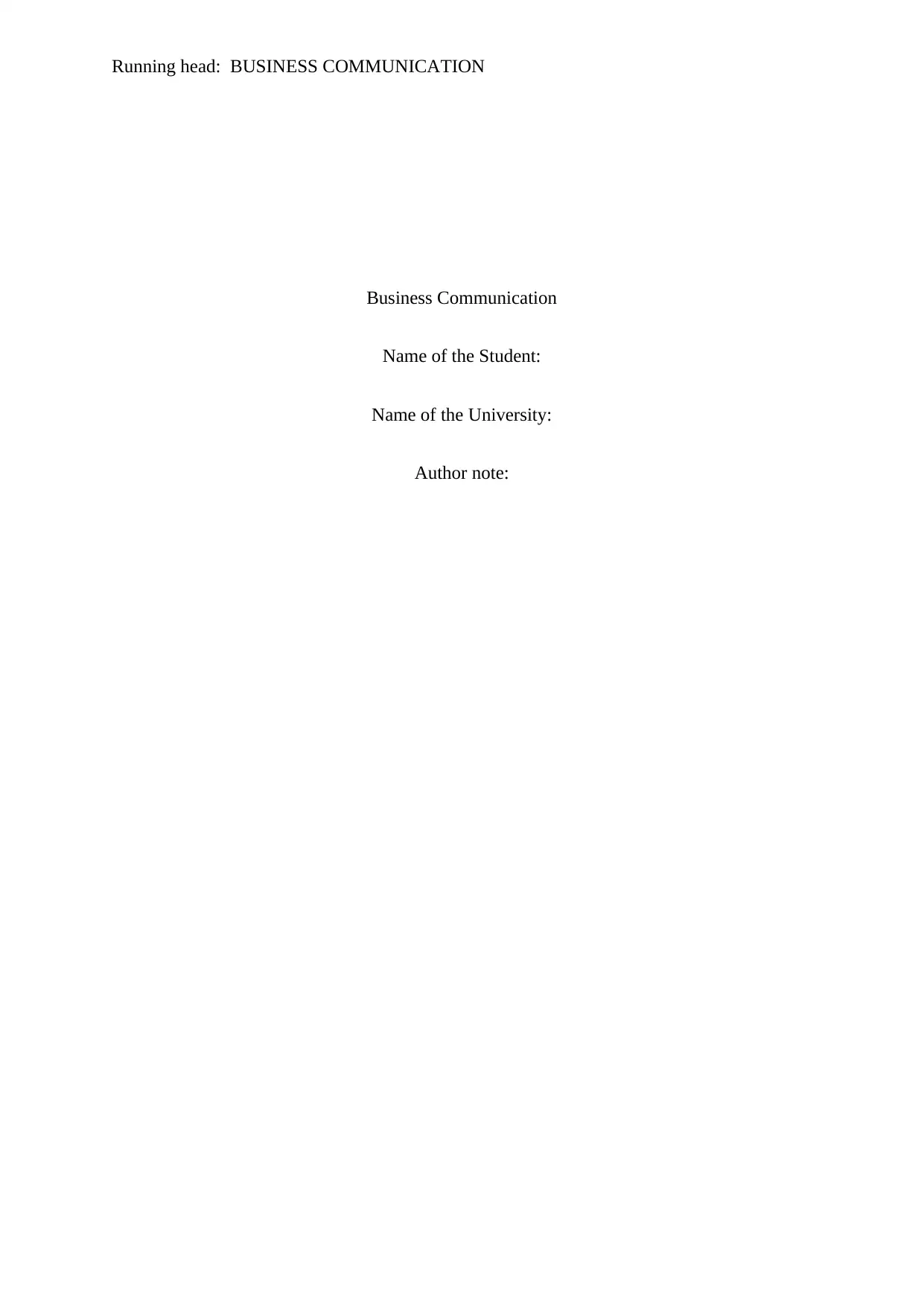
Running head: BUSINESS COMMUNICATION
Business Communication
Name of the Student:
Name of the University:
Author note:
Business Communication
Name of the Student:
Name of the University:
Author note:
Secure Best Marks with AI Grader
Need help grading? Try our AI Grader for instant feedback on your assignments.
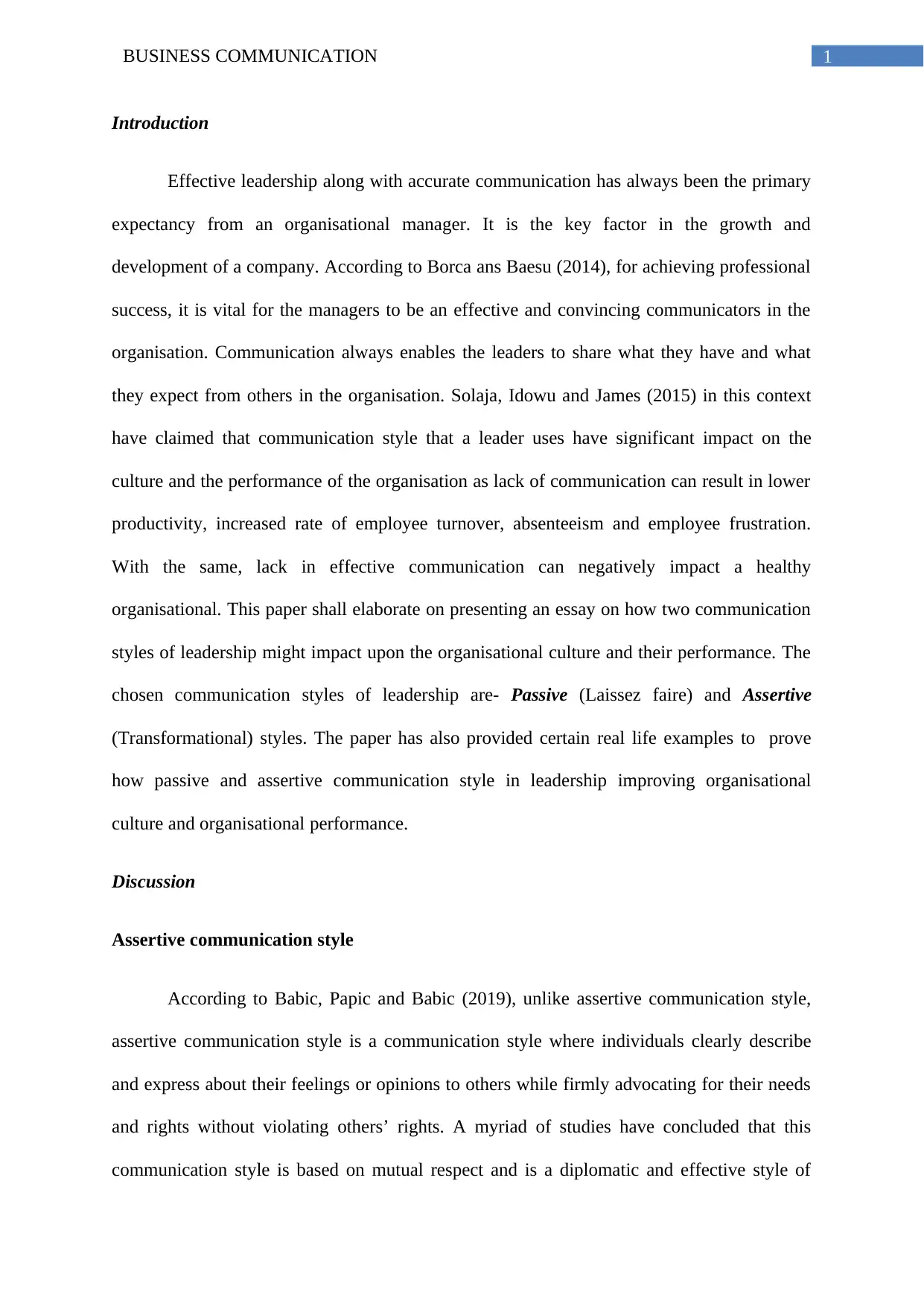
1BUSINESS COMMUNICATION
Introduction
Effective leadership along with accurate communication has always been the primary
expectancy from an organisational manager. It is the key factor in the growth and
development of a company. According to Borca ans Baesu (2014), for achieving professional
success, it is vital for the managers to be an effective and convincing communicators in the
organisation. Communication always enables the leaders to share what they have and what
they expect from others in the organisation. Solaja, Idowu and James (2015) in this context
have claimed that communication style that a leader uses have significant impact on the
culture and the performance of the organisation as lack of communication can result in lower
productivity, increased rate of employee turnover, absenteeism and employee frustration.
With the same, lack in effective communication can negatively impact a healthy
organisational. This paper shall elaborate on presenting an essay on how two communication
styles of leadership might impact upon the organisational culture and their performance. The
chosen communication styles of leadership are- Passive (Laissez faire) and Assertive
(Transformational) styles. The paper has also provided certain real life examples to prove
how passive and assertive communication style in leadership improving organisational
culture and organisational performance.
Discussion
Assertive communication style
According to Babic, Papic and Babic (2019), unlike assertive communication style,
assertive communication style is a communication style where individuals clearly describe
and express about their feelings or opinions to others while firmly advocating for their needs
and rights without violating others’ rights. A myriad of studies have concluded that this
communication style is based on mutual respect and is a diplomatic and effective style of
Introduction
Effective leadership along with accurate communication has always been the primary
expectancy from an organisational manager. It is the key factor in the growth and
development of a company. According to Borca ans Baesu (2014), for achieving professional
success, it is vital for the managers to be an effective and convincing communicators in the
organisation. Communication always enables the leaders to share what they have and what
they expect from others in the organisation. Solaja, Idowu and James (2015) in this context
have claimed that communication style that a leader uses have significant impact on the
culture and the performance of the organisation as lack of communication can result in lower
productivity, increased rate of employee turnover, absenteeism and employee frustration.
With the same, lack in effective communication can negatively impact a healthy
organisational. This paper shall elaborate on presenting an essay on how two communication
styles of leadership might impact upon the organisational culture and their performance. The
chosen communication styles of leadership are- Passive (Laissez faire) and Assertive
(Transformational) styles. The paper has also provided certain real life examples to prove
how passive and assertive communication style in leadership improving organisational
culture and organisational performance.
Discussion
Assertive communication style
According to Babic, Papic and Babic (2019), unlike assertive communication style,
assertive communication style is a communication style where individuals clearly describe
and express about their feelings or opinions to others while firmly advocating for their needs
and rights without violating others’ rights. A myriad of studies have concluded that this
communication style is based on mutual respect and is a diplomatic and effective style of
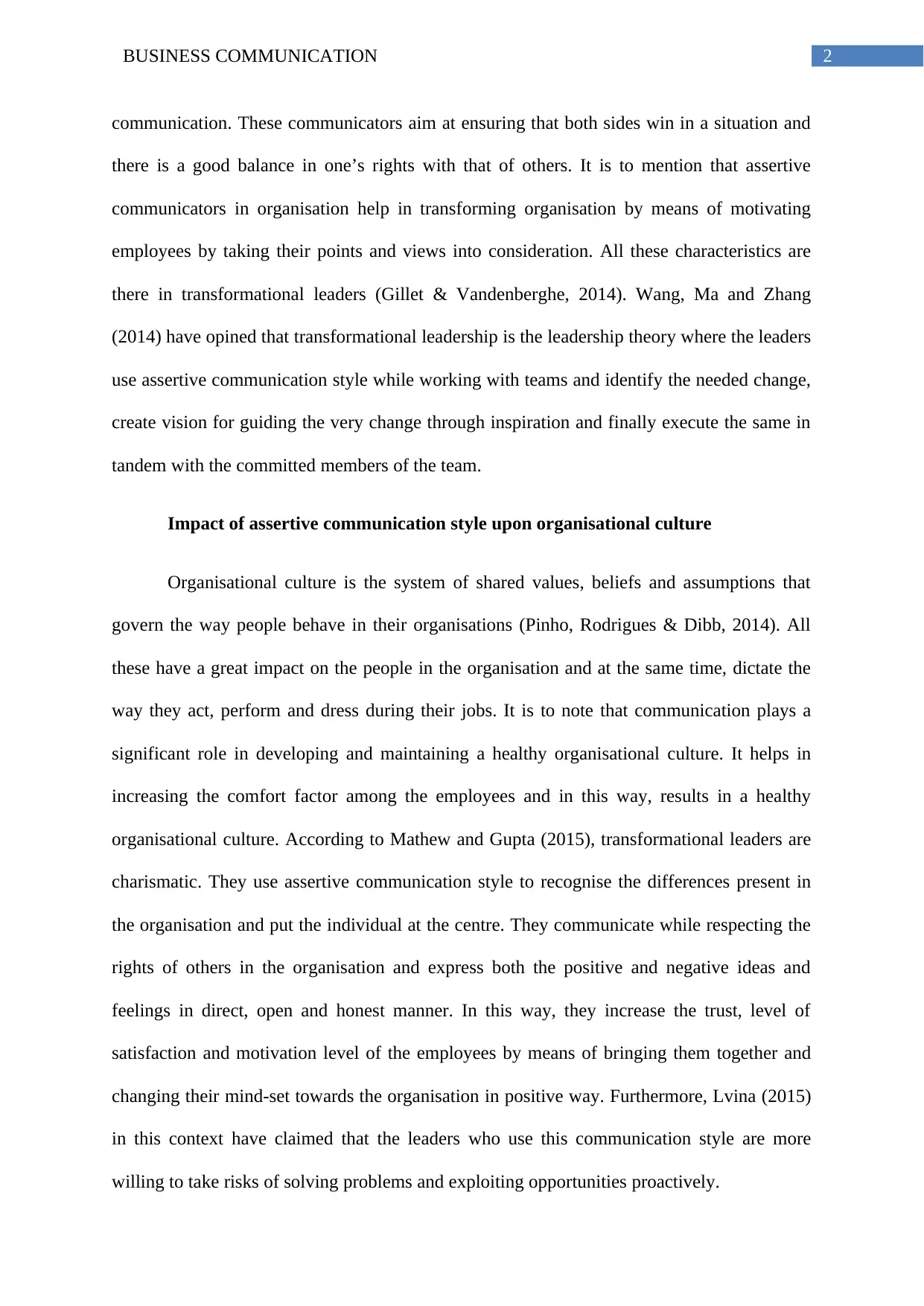
2BUSINESS COMMUNICATION
communication. These communicators aim at ensuring that both sides win in a situation and
there is a good balance in one’s rights with that of others. It is to mention that assertive
communicators in organisation help in transforming organisation by means of motivating
employees by taking their points and views into consideration. All these characteristics are
there in transformational leaders (Gillet & Vandenberghe, 2014). Wang, Ma and Zhang
(2014) have opined that transformational leadership is the leadership theory where the leaders
use assertive communication style while working with teams and identify the needed change,
create vision for guiding the very change through inspiration and finally execute the same in
tandem with the committed members of the team.
Impact of assertive communication style upon organisational culture
Organisational culture is the system of shared values, beliefs and assumptions that
govern the way people behave in their organisations (Pinho, Rodrigues & Dibb, 2014). All
these have a great impact on the people in the organisation and at the same time, dictate the
way they act, perform and dress during their jobs. It is to note that communication plays a
significant role in developing and maintaining a healthy organisational culture. It helps in
increasing the comfort factor among the employees and in this way, results in a healthy
organisational culture. According to Mathew and Gupta (2015), transformational leaders are
charismatic. They use assertive communication style to recognise the differences present in
the organisation and put the individual at the centre. They communicate while respecting the
rights of others in the organisation and express both the positive and negative ideas and
feelings in direct, open and honest manner. In this way, they increase the trust, level of
satisfaction and motivation level of the employees by means of bringing them together and
changing their mind-set towards the organisation in positive way. Furthermore, Lvina (2015)
in this context have claimed that the leaders who use this communication style are more
willing to take risks of solving problems and exploiting opportunities proactively.
communication. These communicators aim at ensuring that both sides win in a situation and
there is a good balance in one’s rights with that of others. It is to mention that assertive
communicators in organisation help in transforming organisation by means of motivating
employees by taking their points and views into consideration. All these characteristics are
there in transformational leaders (Gillet & Vandenberghe, 2014). Wang, Ma and Zhang
(2014) have opined that transformational leadership is the leadership theory where the leaders
use assertive communication style while working with teams and identify the needed change,
create vision for guiding the very change through inspiration and finally execute the same in
tandem with the committed members of the team.
Impact of assertive communication style upon organisational culture
Organisational culture is the system of shared values, beliefs and assumptions that
govern the way people behave in their organisations (Pinho, Rodrigues & Dibb, 2014). All
these have a great impact on the people in the organisation and at the same time, dictate the
way they act, perform and dress during their jobs. It is to note that communication plays a
significant role in developing and maintaining a healthy organisational culture. It helps in
increasing the comfort factor among the employees and in this way, results in a healthy
organisational culture. According to Mathew and Gupta (2015), transformational leaders are
charismatic. They use assertive communication style to recognise the differences present in
the organisation and put the individual at the centre. They communicate while respecting the
rights of others in the organisation and express both the positive and negative ideas and
feelings in direct, open and honest manner. In this way, they increase the trust, level of
satisfaction and motivation level of the employees by means of bringing them together and
changing their mind-set towards the organisation in positive way. Furthermore, Lvina (2015)
in this context have claimed that the leaders who use this communication style are more
willing to take risks of solving problems and exploiting opportunities proactively.
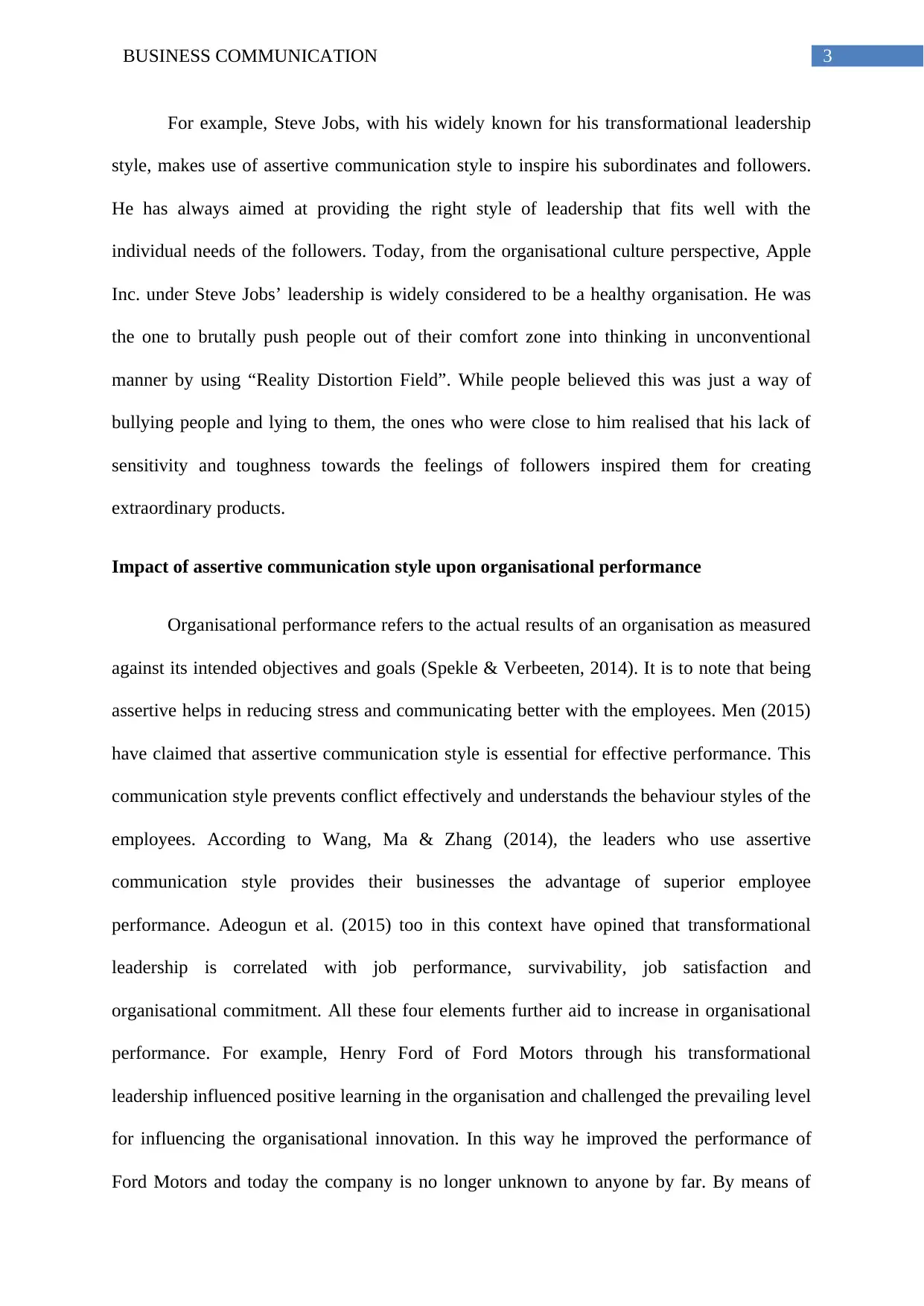
3BUSINESS COMMUNICATION
For example, Steve Jobs, with his widely known for his transformational leadership
style, makes use of assertive communication style to inspire his subordinates and followers.
He has always aimed at providing the right style of leadership that fits well with the
individual needs of the followers. Today, from the organisational culture perspective, Apple
Inc. under Steve Jobs’ leadership is widely considered to be a healthy organisation. He was
the one to brutally push people out of their comfort zone into thinking in unconventional
manner by using “Reality Distortion Field”. While people believed this was just a way of
bullying people and lying to them, the ones who were close to him realised that his lack of
sensitivity and toughness towards the feelings of followers inspired them for creating
extraordinary products.
Impact of assertive communication style upon organisational performance
Organisational performance refers to the actual results of an organisation as measured
against its intended objectives and goals (Spekle & Verbeeten, 2014). It is to note that being
assertive helps in reducing stress and communicating better with the employees. Men (2015)
have claimed that assertive communication style is essential for effective performance. This
communication style prevents conflict effectively and understands the behaviour styles of the
employees. According to Wang, Ma & Zhang (2014), the leaders who use assertive
communication style provides their businesses the advantage of superior employee
performance. Adeogun et al. (2015) too in this context have opined that transformational
leadership is correlated with job performance, survivability, job satisfaction and
organisational commitment. All these four elements further aid to increase in organisational
performance. For example, Henry Ford of Ford Motors through his transformational
leadership influenced positive learning in the organisation and challenged the prevailing level
for influencing the organisational innovation. In this way he improved the performance of
Ford Motors and today the company is no longer unknown to anyone by far. By means of
For example, Steve Jobs, with his widely known for his transformational leadership
style, makes use of assertive communication style to inspire his subordinates and followers.
He has always aimed at providing the right style of leadership that fits well with the
individual needs of the followers. Today, from the organisational culture perspective, Apple
Inc. under Steve Jobs’ leadership is widely considered to be a healthy organisation. He was
the one to brutally push people out of their comfort zone into thinking in unconventional
manner by using “Reality Distortion Field”. While people believed this was just a way of
bullying people and lying to them, the ones who were close to him realised that his lack of
sensitivity and toughness towards the feelings of followers inspired them for creating
extraordinary products.
Impact of assertive communication style upon organisational performance
Organisational performance refers to the actual results of an organisation as measured
against its intended objectives and goals (Spekle & Verbeeten, 2014). It is to note that being
assertive helps in reducing stress and communicating better with the employees. Men (2015)
have claimed that assertive communication style is essential for effective performance. This
communication style prevents conflict effectively and understands the behaviour styles of the
employees. According to Wang, Ma & Zhang (2014), the leaders who use assertive
communication style provides their businesses the advantage of superior employee
performance. Adeogun et al. (2015) too in this context have opined that transformational
leadership is correlated with job performance, survivability, job satisfaction and
organisational commitment. All these four elements further aid to increase in organisational
performance. For example, Henry Ford of Ford Motors through his transformational
leadership influenced positive learning in the organisation and challenged the prevailing level
for influencing the organisational innovation. In this way he improved the performance of
Ford Motors and today the company is no longer unknown to anyone by far. By means of
Secure Best Marks with AI Grader
Need help grading? Try our AI Grader for instant feedback on your assignments.
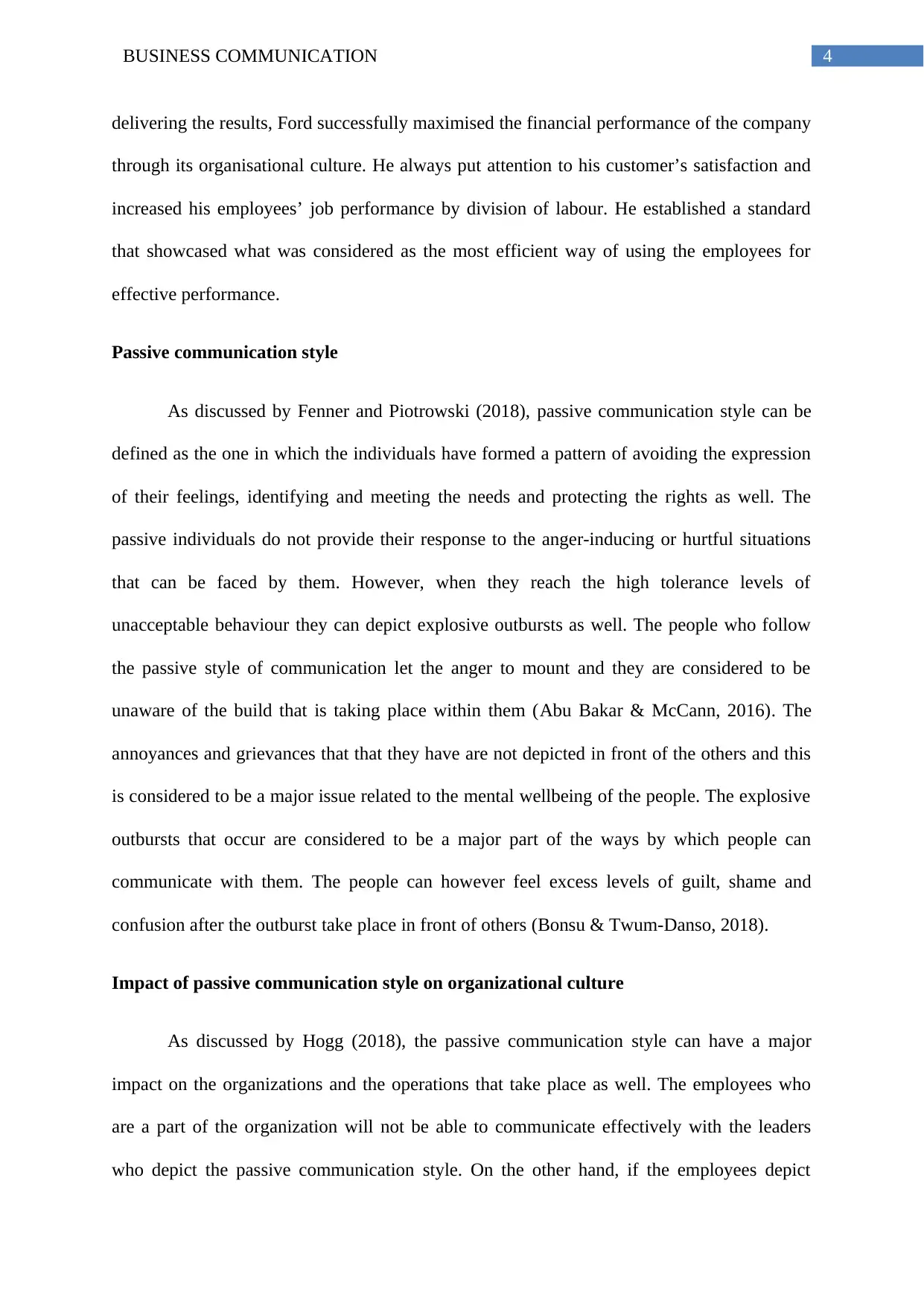
4BUSINESS COMMUNICATION
delivering the results, Ford successfully maximised the financial performance of the company
through its organisational culture. He always put attention to his customer’s satisfaction and
increased his employees’ job performance by division of labour. He established a standard
that showcased what was considered as the most efficient way of using the employees for
effective performance.
Passive communication style
As discussed by Fenner and Piotrowski (2018), passive communication style can be
defined as the one in which the individuals have formed a pattern of avoiding the expression
of their feelings, identifying and meeting the needs and protecting the rights as well. The
passive individuals do not provide their response to the anger-inducing or hurtful situations
that can be faced by them. However, when they reach the high tolerance levels of
unacceptable behaviour they can depict explosive outbursts as well. The people who follow
the passive style of communication let the anger to mount and they are considered to be
unaware of the build that is taking place within them (Abu Bakar & McCann, 2016). The
annoyances and grievances that that they have are not depicted in front of the others and this
is considered to be a major issue related to the mental wellbeing of the people. The explosive
outbursts that occur are considered to be a major part of the ways by which people can
communicate with them. The people can however feel excess levels of guilt, shame and
confusion after the outburst take place in front of others (Bonsu & Twum-Danso, 2018).
Impact of passive communication style on organizational culture
As discussed by Hogg (2018), the passive communication style can have a major
impact on the organizations and the operations that take place as well. The employees who
are a part of the organization will not be able to communicate effectively with the leaders
who depict the passive communication style. On the other hand, if the employees depict
delivering the results, Ford successfully maximised the financial performance of the company
through its organisational culture. He always put attention to his customer’s satisfaction and
increased his employees’ job performance by division of labour. He established a standard
that showcased what was considered as the most efficient way of using the employees for
effective performance.
Passive communication style
As discussed by Fenner and Piotrowski (2018), passive communication style can be
defined as the one in which the individuals have formed a pattern of avoiding the expression
of their feelings, identifying and meeting the needs and protecting the rights as well. The
passive individuals do not provide their response to the anger-inducing or hurtful situations
that can be faced by them. However, when they reach the high tolerance levels of
unacceptable behaviour they can depict explosive outbursts as well. The people who follow
the passive style of communication let the anger to mount and they are considered to be
unaware of the build that is taking place within them (Abu Bakar & McCann, 2016). The
annoyances and grievances that that they have are not depicted in front of the others and this
is considered to be a major issue related to the mental wellbeing of the people. The explosive
outbursts that occur are considered to be a major part of the ways by which people can
communicate with them. The people can however feel excess levels of guilt, shame and
confusion after the outburst take place in front of others (Bonsu & Twum-Danso, 2018).
Impact of passive communication style on organizational culture
As discussed by Hogg (2018), the passive communication style can have a major
impact on the organizations and the operations that take place as well. The employees who
are a part of the organization will not be able to communicate effectively with the leaders
who depict the passive communication style. On the other hand, if the employees depict
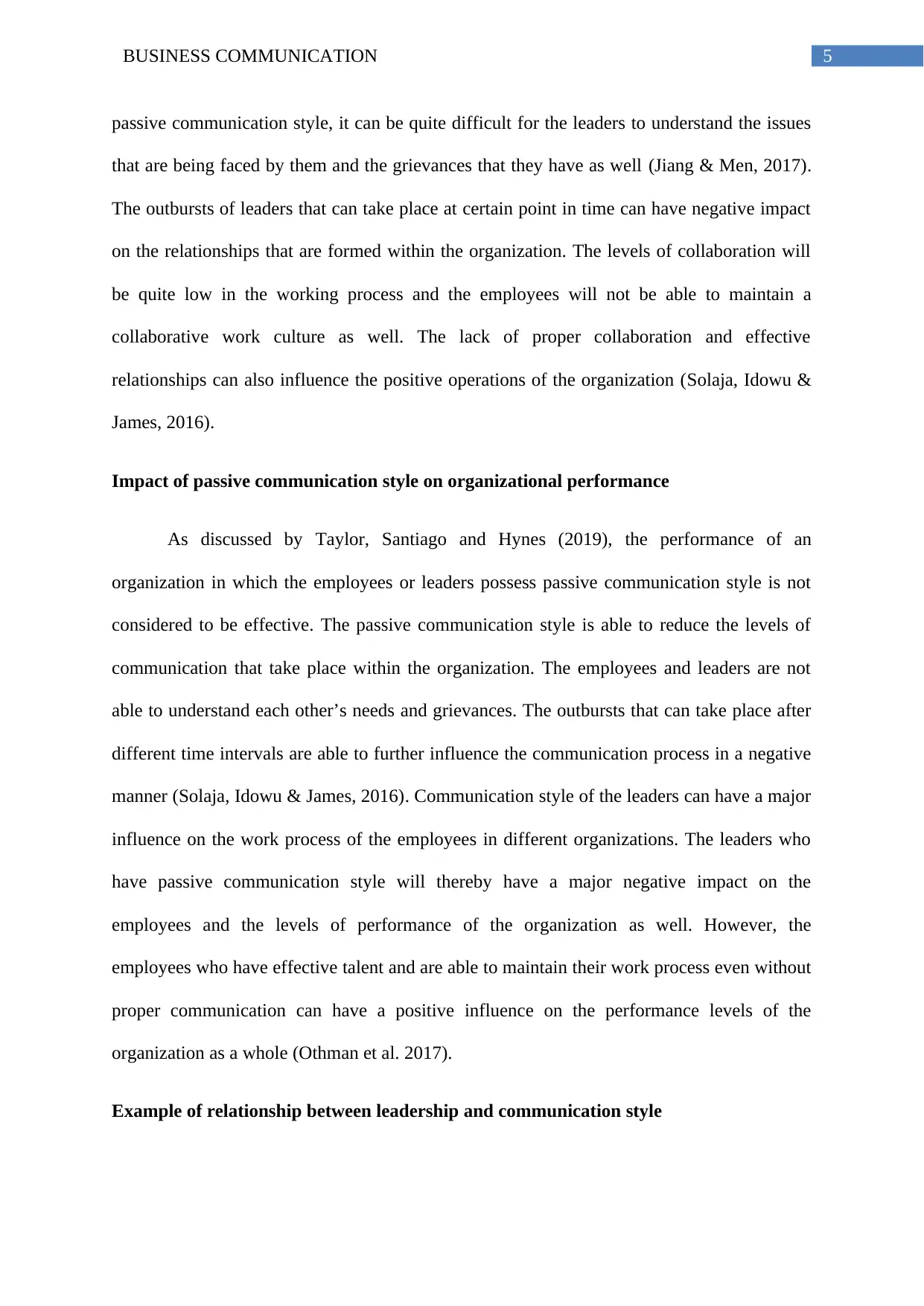
5BUSINESS COMMUNICATION
passive communication style, it can be quite difficult for the leaders to understand the issues
that are being faced by them and the grievances that they have as well (Jiang & Men, 2017).
The outbursts of leaders that can take place at certain point in time can have negative impact
on the relationships that are formed within the organization. The levels of collaboration will
be quite low in the working process and the employees will not be able to maintain a
collaborative work culture as well. The lack of proper collaboration and effective
relationships can also influence the positive operations of the organization (Solaja, Idowu &
James, 2016).
Impact of passive communication style on organizational performance
As discussed by Taylor, Santiago and Hynes (2019), the performance of an
organization in which the employees or leaders possess passive communication style is not
considered to be effective. The passive communication style is able to reduce the levels of
communication that take place within the organization. The employees and leaders are not
able to understand each other’s needs and grievances. The outbursts that can take place after
different time intervals are able to further influence the communication process in a negative
manner (Solaja, Idowu & James, 2016). Communication style of the leaders can have a major
influence on the work process of the employees in different organizations. The leaders who
have passive communication style will thereby have a major negative impact on the
employees and the levels of performance of the organization as well. However, the
employees who have effective talent and are able to maintain their work process even without
proper communication can have a positive influence on the performance levels of the
organization as a whole (Othman et al. 2017).
Example of relationship between leadership and communication style
passive communication style, it can be quite difficult for the leaders to understand the issues
that are being faced by them and the grievances that they have as well (Jiang & Men, 2017).
The outbursts of leaders that can take place at certain point in time can have negative impact
on the relationships that are formed within the organization. The levels of collaboration will
be quite low in the working process and the employees will not be able to maintain a
collaborative work culture as well. The lack of proper collaboration and effective
relationships can also influence the positive operations of the organization (Solaja, Idowu &
James, 2016).
Impact of passive communication style on organizational performance
As discussed by Taylor, Santiago and Hynes (2019), the performance of an
organization in which the employees or leaders possess passive communication style is not
considered to be effective. The passive communication style is able to reduce the levels of
communication that take place within the organization. The employees and leaders are not
able to understand each other’s needs and grievances. The outbursts that can take place after
different time intervals are able to further influence the communication process in a negative
manner (Solaja, Idowu & James, 2016). Communication style of the leaders can have a major
influence on the work process of the employees in different organizations. The leaders who
have passive communication style will thereby have a major negative impact on the
employees and the levels of performance of the organization as well. However, the
employees who have effective talent and are able to maintain their work process even without
proper communication can have a positive influence on the performance levels of the
organization as a whole (Othman et al. 2017).
Example of relationship between leadership and communication style
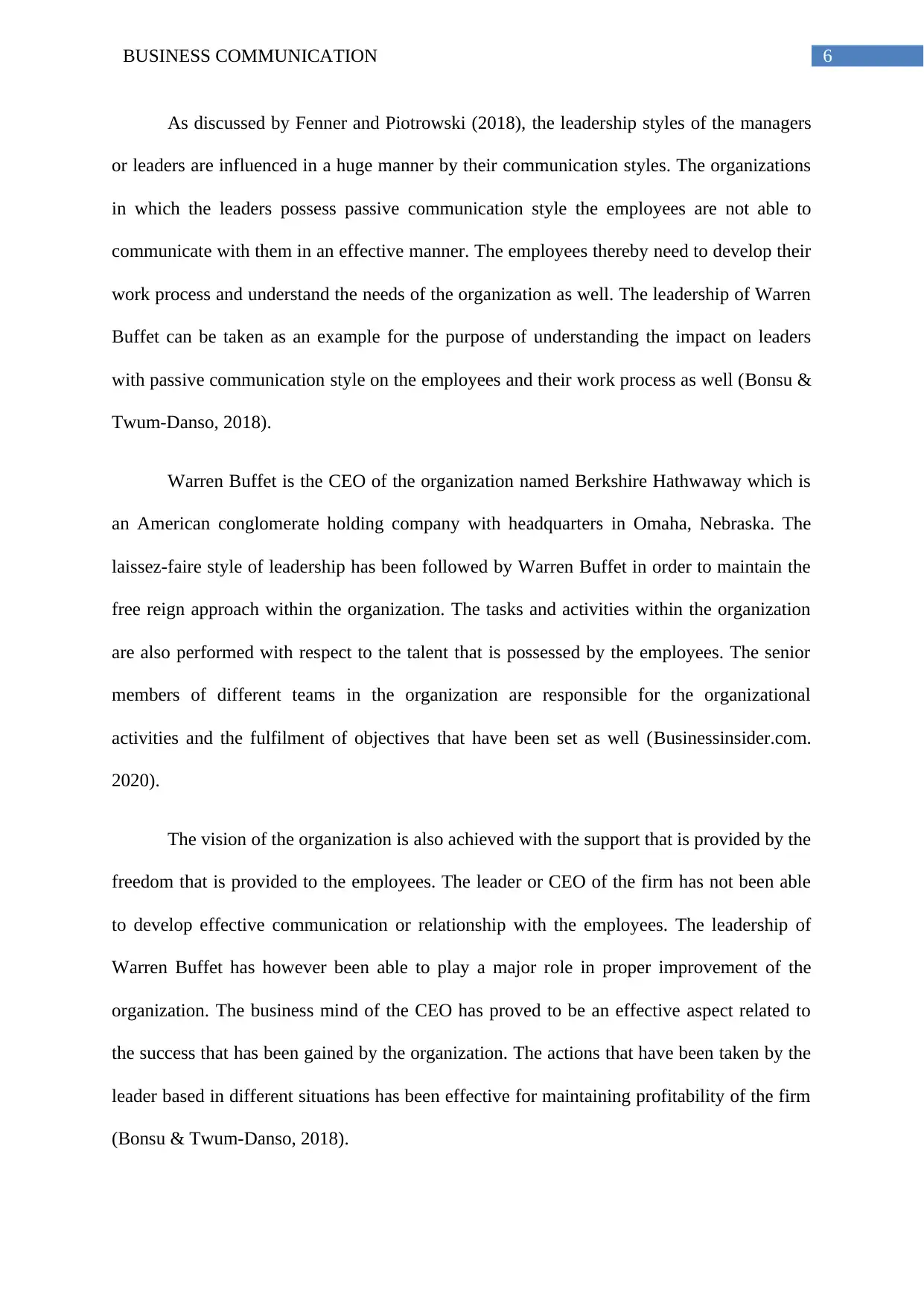
6BUSINESS COMMUNICATION
As discussed by Fenner and Piotrowski (2018), the leadership styles of the managers
or leaders are influenced in a huge manner by their communication styles. The organizations
in which the leaders possess passive communication style the employees are not able to
communicate with them in an effective manner. The employees thereby need to develop their
work process and understand the needs of the organization as well. The leadership of Warren
Buffet can be taken as an example for the purpose of understanding the impact on leaders
with passive communication style on the employees and their work process as well (Bonsu &
Twum-Danso, 2018).
Warren Buffet is the CEO of the organization named Berkshire Hathwaway which is
an American conglomerate holding company with headquarters in Omaha, Nebraska. The
laissez-faire style of leadership has been followed by Warren Buffet in order to maintain the
free reign approach within the organization. The tasks and activities within the organization
are also performed with respect to the talent that is possessed by the employees. The senior
members of different teams in the organization are responsible for the organizational
activities and the fulfilment of objectives that have been set as well (Businessinsider.com.
2020).
The vision of the organization is also achieved with the support that is provided by the
freedom that is provided to the employees. The leader or CEO of the firm has not been able
to develop effective communication or relationship with the employees. The leadership of
Warren Buffet has however been able to play a major role in proper improvement of the
organization. The business mind of the CEO has proved to be an effective aspect related to
the success that has been gained by the organization. The actions that have been taken by the
leader based in different situations has been effective for maintaining profitability of the firm
(Bonsu & Twum-Danso, 2018).
As discussed by Fenner and Piotrowski (2018), the leadership styles of the managers
or leaders are influenced in a huge manner by their communication styles. The organizations
in which the leaders possess passive communication style the employees are not able to
communicate with them in an effective manner. The employees thereby need to develop their
work process and understand the needs of the organization as well. The leadership of Warren
Buffet can be taken as an example for the purpose of understanding the impact on leaders
with passive communication style on the employees and their work process as well (Bonsu &
Twum-Danso, 2018).
Warren Buffet is the CEO of the organization named Berkshire Hathwaway which is
an American conglomerate holding company with headquarters in Omaha, Nebraska. The
laissez-faire style of leadership has been followed by Warren Buffet in order to maintain the
free reign approach within the organization. The tasks and activities within the organization
are also performed with respect to the talent that is possessed by the employees. The senior
members of different teams in the organization are responsible for the organizational
activities and the fulfilment of objectives that have been set as well (Businessinsider.com.
2020).
The vision of the organization is also achieved with the support that is provided by the
freedom that is provided to the employees. The leader or CEO of the firm has not been able
to develop effective communication or relationship with the employees. The leadership of
Warren Buffet has however been able to play a major role in proper improvement of the
organization. The business mind of the CEO has proved to be an effective aspect related to
the success that has been gained by the organization. The actions that have been taken by the
leader based in different situations has been effective for maintaining profitability of the firm
(Bonsu & Twum-Danso, 2018).
Paraphrase This Document
Need a fresh take? Get an instant paraphrase of this document with our AI Paraphraser
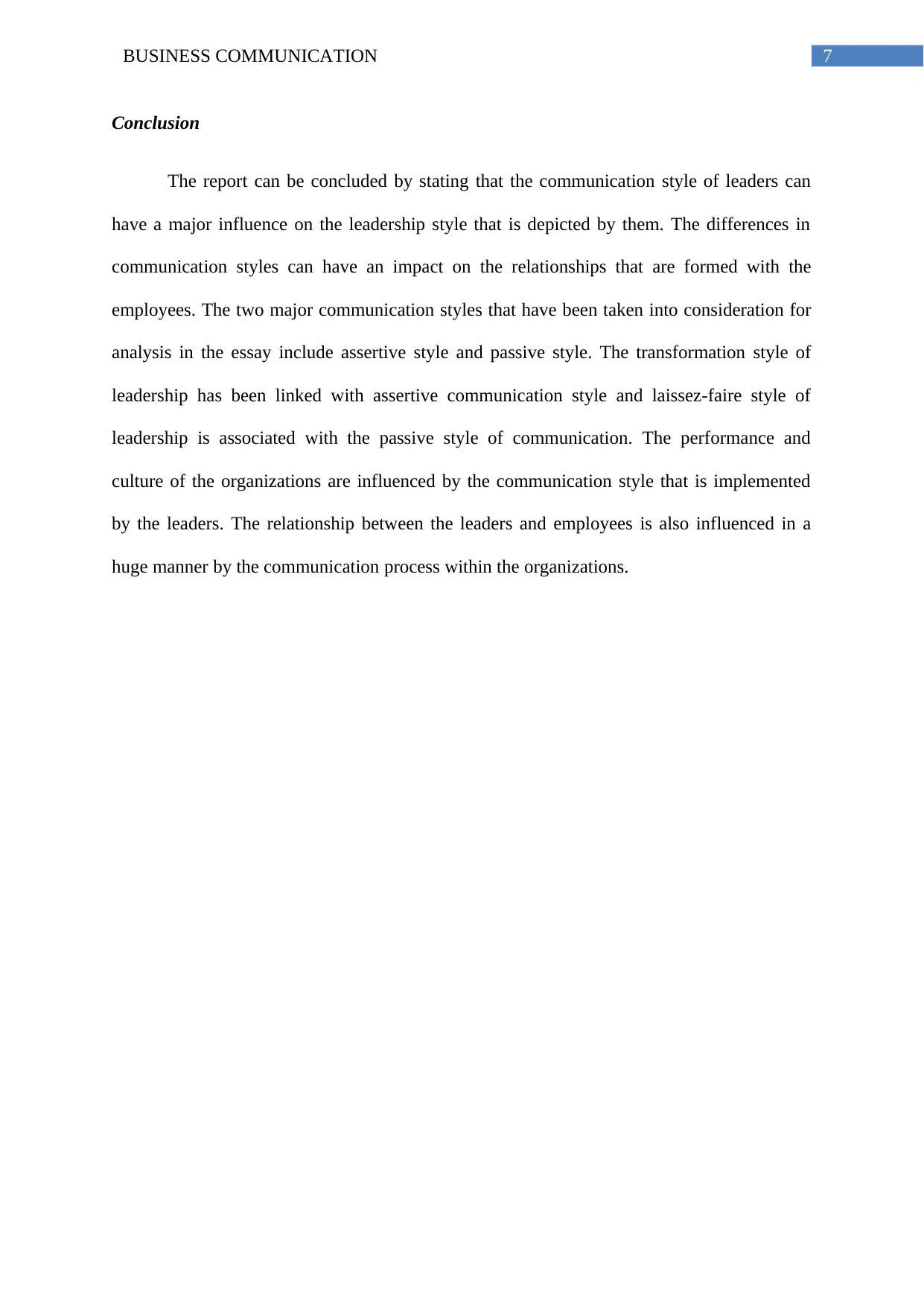
7BUSINESS COMMUNICATION
Conclusion
The report can be concluded by stating that the communication style of leaders can
have a major influence on the leadership style that is depicted by them. The differences in
communication styles can have an impact on the relationships that are formed with the
employees. The two major communication styles that have been taken into consideration for
analysis in the essay include assertive style and passive style. The transformation style of
leadership has been linked with assertive communication style and laissez-faire style of
leadership is associated with the passive style of communication. The performance and
culture of the organizations are influenced by the communication style that is implemented
by the leaders. The relationship between the leaders and employees is also influenced in a
huge manner by the communication process within the organizations.
Conclusion
The report can be concluded by stating that the communication style of leaders can
have a major influence on the leadership style that is depicted by them. The differences in
communication styles can have an impact on the relationships that are formed with the
employees. The two major communication styles that have been taken into consideration for
analysis in the essay include assertive style and passive style. The transformation style of
leadership has been linked with assertive communication style and laissez-faire style of
leadership is associated with the passive style of communication. The performance and
culture of the organizations are influenced by the communication style that is implemented
by the leaders. The relationship between the leaders and employees is also influenced in a
huge manner by the communication process within the organizations.
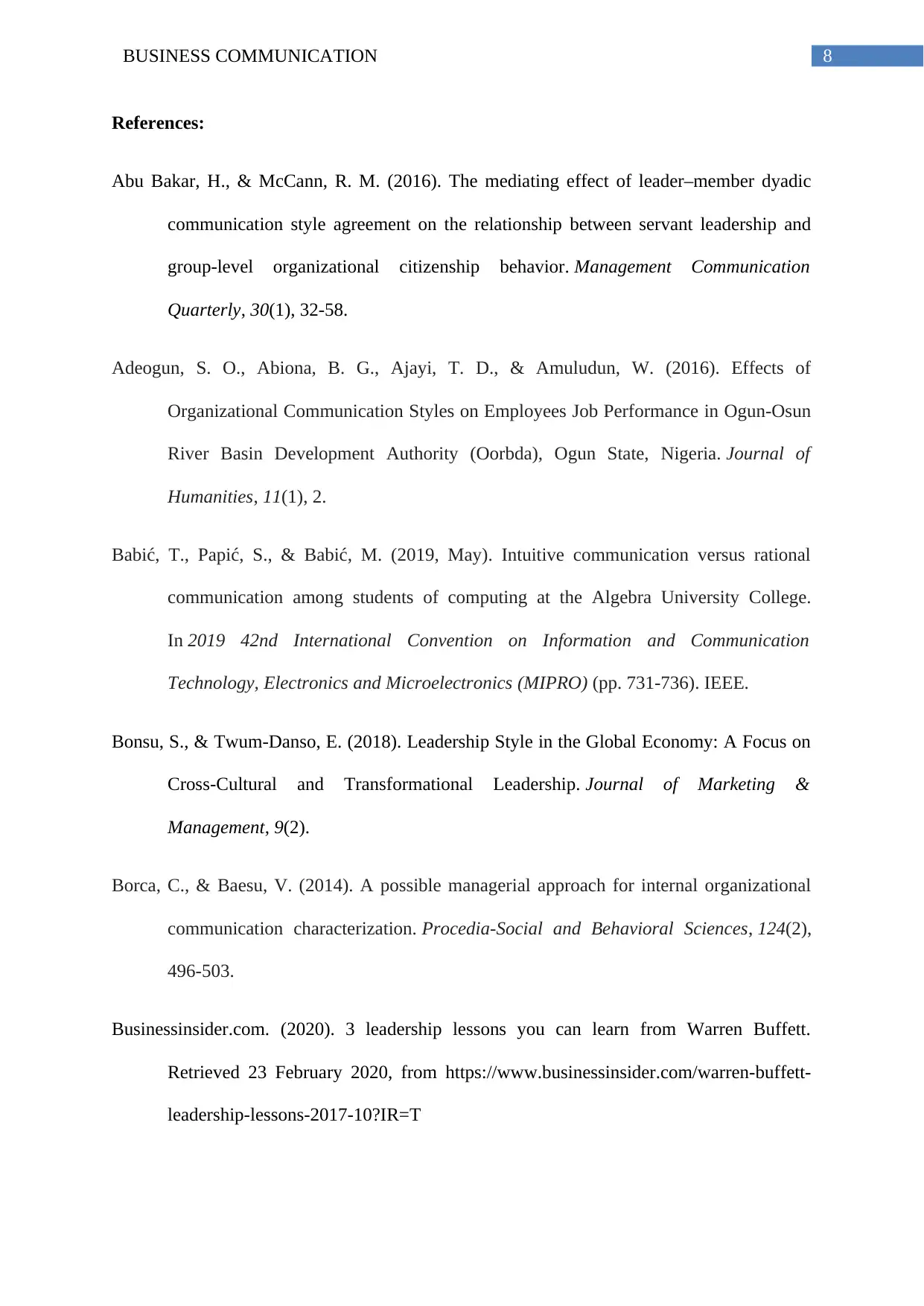
8BUSINESS COMMUNICATION
References:
Abu Bakar, H., & McCann, R. M. (2016). The mediating effect of leader–member dyadic
communication style agreement on the relationship between servant leadership and
group-level organizational citizenship behavior. Management Communication
Quarterly, 30(1), 32-58.
Adeogun, S. O., Abiona, B. G., Ajayi, T. D., & Amuludun, W. (2016). Effects of
Organizational Communication Styles on Employees Job Performance in Ogun-Osun
River Basin Development Authority (Oorbda), Ogun State, Nigeria. Journal of
Humanities, 11(1), 2.
Babić, T., Papić, S., & Babić, M. (2019, May). Intuitive communication versus rational
communication among students of computing at the Algebra University College.
In 2019 42nd International Convention on Information and Communication
Technology, Electronics and Microelectronics (MIPRO) (pp. 731-736). IEEE.
Bonsu, S., & Twum-Danso, E. (2018). Leadership Style in the Global Economy: A Focus on
Cross-Cultural and Transformational Leadership. Journal of Marketing &
Management, 9(2).
Borca, C., & Baesu, V. (2014). A possible managerial approach for internal organizational
communication characterization. Procedia-Social and Behavioral Sciences, 124(2),
496-503.
Businessinsider.com. (2020). 3 leadership lessons you can learn from Warren Buffett.
Retrieved 23 February 2020, from https://www.businessinsider.com/warren-buffett-
leadership-lessons-2017-10?IR=T
References:
Abu Bakar, H., & McCann, R. M. (2016). The mediating effect of leader–member dyadic
communication style agreement on the relationship between servant leadership and
group-level organizational citizenship behavior. Management Communication
Quarterly, 30(1), 32-58.
Adeogun, S. O., Abiona, B. G., Ajayi, T. D., & Amuludun, W. (2016). Effects of
Organizational Communication Styles on Employees Job Performance in Ogun-Osun
River Basin Development Authority (Oorbda), Ogun State, Nigeria. Journal of
Humanities, 11(1), 2.
Babić, T., Papić, S., & Babić, M. (2019, May). Intuitive communication versus rational
communication among students of computing at the Algebra University College.
In 2019 42nd International Convention on Information and Communication
Technology, Electronics and Microelectronics (MIPRO) (pp. 731-736). IEEE.
Bonsu, S., & Twum-Danso, E. (2018). Leadership Style in the Global Economy: A Focus on
Cross-Cultural and Transformational Leadership. Journal of Marketing &
Management, 9(2).
Borca, C., & Baesu, V. (2014). A possible managerial approach for internal organizational
communication characterization. Procedia-Social and Behavioral Sciences, 124(2),
496-503.
Businessinsider.com. (2020). 3 leadership lessons you can learn from Warren Buffett.
Retrieved 23 February 2020, from https://www.businessinsider.com/warren-buffett-
leadership-lessons-2017-10?IR=T
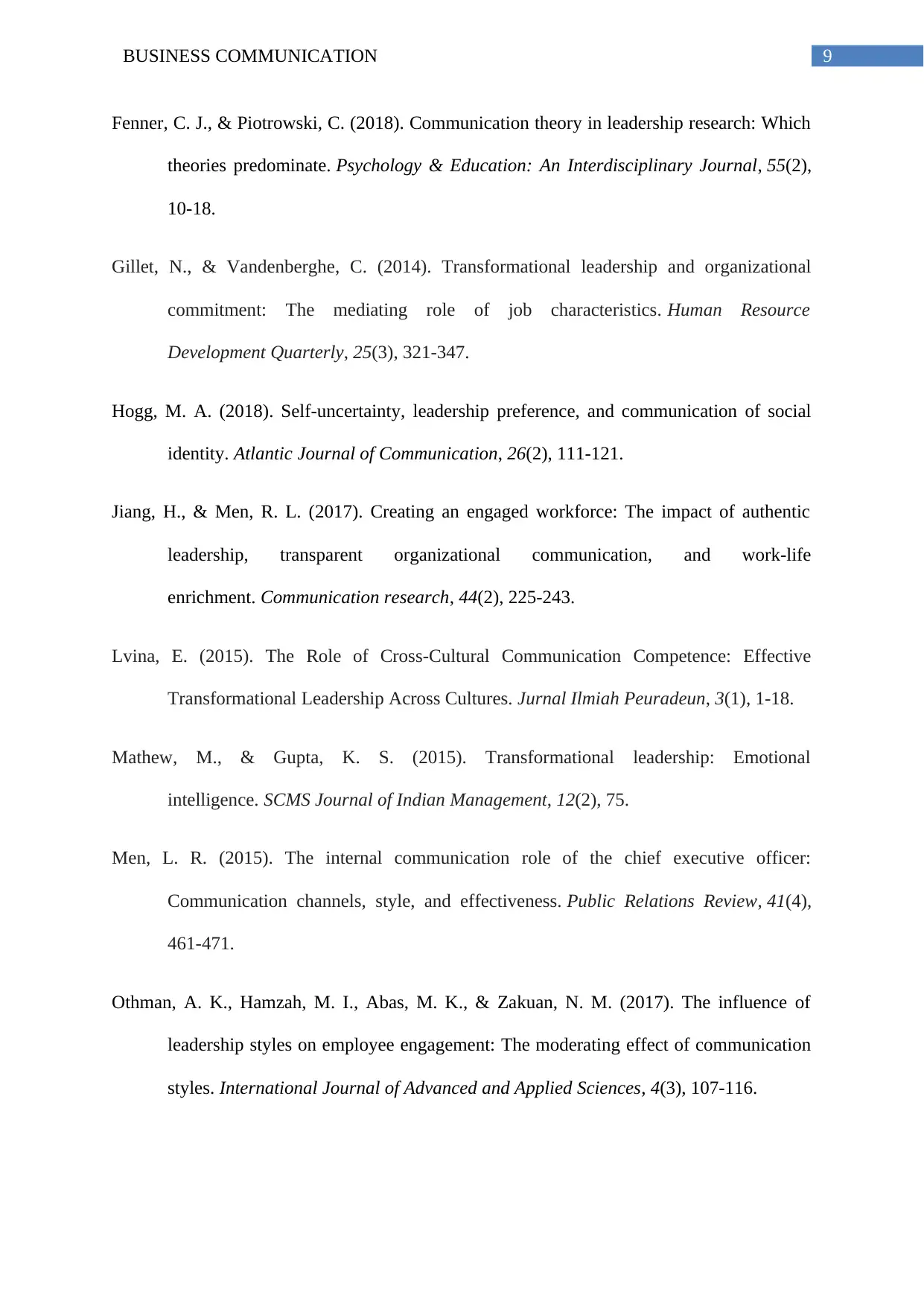
9BUSINESS COMMUNICATION
Fenner, C. J., & Piotrowski, C. (2018). Communication theory in leadership research: Which
theories predominate. Psychology & Education: An Interdisciplinary Journal, 55(2),
10-18.
Gillet, N., & Vandenberghe, C. (2014). Transformational leadership and organizational
commitment: The mediating role of job characteristics. Human Resource
Development Quarterly, 25(3), 321-347.
Hogg, M. A. (2018). Self-uncertainty, leadership preference, and communication of social
identity. Atlantic Journal of Communication, 26(2), 111-121.
Jiang, H., & Men, R. L. (2017). Creating an engaged workforce: The impact of authentic
leadership, transparent organizational communication, and work-life
enrichment. Communication research, 44(2), 225-243.
Lvina, E. (2015). The Role of Cross-Cultural Communication Competence: Effective
Transformational Leadership Across Cultures. Jurnal Ilmiah Peuradeun, 3(1), 1-18.
Mathew, M., & Gupta, K. S. (2015). Transformational leadership: Emotional
intelligence. SCMS Journal of Indian Management, 12(2), 75.
Men, L. R. (2015). The internal communication role of the chief executive officer:
Communication channels, style, and effectiveness. Public Relations Review, 41(4),
461-471.
Othman, A. K., Hamzah, M. I., Abas, M. K., & Zakuan, N. M. (2017). The influence of
leadership styles on employee engagement: The moderating effect of communication
styles. International Journal of Advanced and Applied Sciences, 4(3), 107-116.
Fenner, C. J., & Piotrowski, C. (2018). Communication theory in leadership research: Which
theories predominate. Psychology & Education: An Interdisciplinary Journal, 55(2),
10-18.
Gillet, N., & Vandenberghe, C. (2014). Transformational leadership and organizational
commitment: The mediating role of job characteristics. Human Resource
Development Quarterly, 25(3), 321-347.
Hogg, M. A. (2018). Self-uncertainty, leadership preference, and communication of social
identity. Atlantic Journal of Communication, 26(2), 111-121.
Jiang, H., & Men, R. L. (2017). Creating an engaged workforce: The impact of authentic
leadership, transparent organizational communication, and work-life
enrichment. Communication research, 44(2), 225-243.
Lvina, E. (2015). The Role of Cross-Cultural Communication Competence: Effective
Transformational Leadership Across Cultures. Jurnal Ilmiah Peuradeun, 3(1), 1-18.
Mathew, M., & Gupta, K. S. (2015). Transformational leadership: Emotional
intelligence. SCMS Journal of Indian Management, 12(2), 75.
Men, L. R. (2015). The internal communication role of the chief executive officer:
Communication channels, style, and effectiveness. Public Relations Review, 41(4),
461-471.
Othman, A. K., Hamzah, M. I., Abas, M. K., & Zakuan, N. M. (2017). The influence of
leadership styles on employee engagement: The moderating effect of communication
styles. International Journal of Advanced and Applied Sciences, 4(3), 107-116.
Secure Best Marks with AI Grader
Need help grading? Try our AI Grader for instant feedback on your assignments.
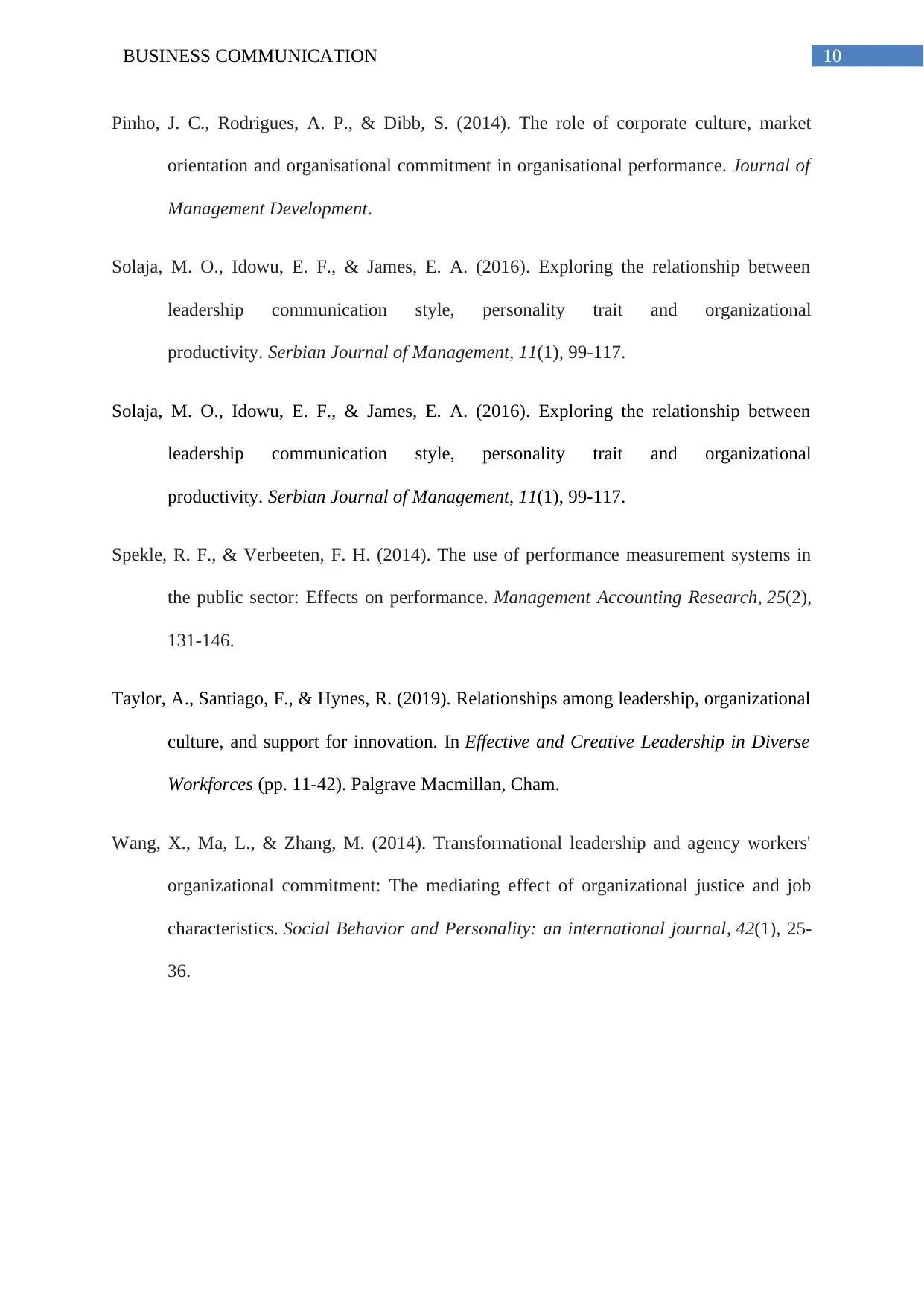
10BUSINESS COMMUNICATION
Pinho, J. C., Rodrigues, A. P., & Dibb, S. (2014). The role of corporate culture, market
orientation and organisational commitment in organisational performance. Journal of
Management Development.
Solaja, M. O., Idowu, E. F., & James, E. A. (2016). Exploring the relationship between
leadership communication style, personality trait and organizational
productivity. Serbian Journal of Management, 11(1), 99-117.
Solaja, M. O., Idowu, E. F., & James, E. A. (2016). Exploring the relationship between
leadership communication style, personality trait and organizational
productivity. Serbian Journal of Management, 11(1), 99-117.
Spekle, R. F., & Verbeeten, F. H. (2014). The use of performance measurement systems in
the public sector: Effects on performance. Management Accounting Research, 25(2),
131-146.
Taylor, A., Santiago, F., & Hynes, R. (2019). Relationships among leadership, organizational
culture, and support for innovation. In Effective and Creative Leadership in Diverse
Workforces (pp. 11-42). Palgrave Macmillan, Cham.
Wang, X., Ma, L., & Zhang, M. (2014). Transformational leadership and agency workers'
organizational commitment: The mediating effect of organizational justice and job
characteristics. Social Behavior and Personality: an international journal, 42(1), 25-
36.
Pinho, J. C., Rodrigues, A. P., & Dibb, S. (2014). The role of corporate culture, market
orientation and organisational commitment in organisational performance. Journal of
Management Development.
Solaja, M. O., Idowu, E. F., & James, E. A. (2016). Exploring the relationship between
leadership communication style, personality trait and organizational
productivity. Serbian Journal of Management, 11(1), 99-117.
Solaja, M. O., Idowu, E. F., & James, E. A. (2016). Exploring the relationship between
leadership communication style, personality trait and organizational
productivity. Serbian Journal of Management, 11(1), 99-117.
Spekle, R. F., & Verbeeten, F. H. (2014). The use of performance measurement systems in
the public sector: Effects on performance. Management Accounting Research, 25(2),
131-146.
Taylor, A., Santiago, F., & Hynes, R. (2019). Relationships among leadership, organizational
culture, and support for innovation. In Effective and Creative Leadership in Diverse
Workforces (pp. 11-42). Palgrave Macmillan, Cham.
Wang, X., Ma, L., & Zhang, M. (2014). Transformational leadership and agency workers'
organizational commitment: The mediating effect of organizational justice and job
characteristics. Social Behavior and Personality: an international journal, 42(1), 25-
36.
1 out of 11
Related Documents
Your All-in-One AI-Powered Toolkit for Academic Success.
+13062052269
info@desklib.com
Available 24*7 on WhatsApp / Email
![[object Object]](/_next/static/media/star-bottom.7253800d.svg)
Unlock your academic potential
© 2024 | Zucol Services PVT LTD | All rights reserved.





